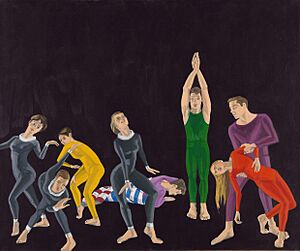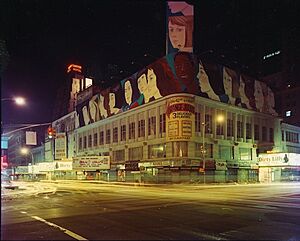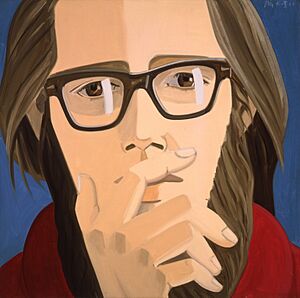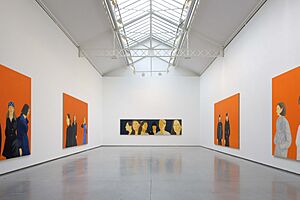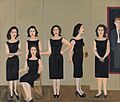Alex Katz facts for kids
Quick facts for kids
Alex Katz
|
|
|---|---|

Katz in 2006
|
|
| Born | July 24, 1927 New York City, U.S.
|
| Education | The Cooper Union, Skowhegan School of Painting and Sculpture |
| Known for | Sculpture, Painting, Printmaking |
| Movement | East Coast Figurative painting, New Realism, Pop Art |
| Spouse(s) | Ada Katz (m. 1958) |
Alex Katz, born on July 24, 1927, is a famous American artist. He creates paintings, sculptures, and prints. His art has been shown in many exhibitions around the world since 1951. He is especially known for his large paintings. These paintings have simple, bold designs and bright colors. Many people see his style as an early form of Pop Art.
Contents
Alex Katz: Early Life and Training
Alex Katz was born on July 24, 1927, in Brooklyn, New York City. His family moved to St. Albans, Queens, in 1928, where he grew up.
From 1946 to 1949, Alex studied art at The Cooper Union in New York. Then, from 1949 to 1950, he went to the Skowhegan School of Painting and Sculpture in Maine. Skowhegan was very important for him. It taught him to paint outdoors, directly from life. This way of painting, called plein air, helped him decide to dedicate his life to art.
Every year, from early June to mid-September, Katz leaves his home in SoHo, New York. He moves to a old farmhouse in Lincolnville, Maine. He has been spending his summers there since 1954. He also has a special connection with Colby College in Maine.
In 1957, he met Ada Del Moro at an art gallery. She had studied biology at New York University. They got married on February 1, 1958. In 1960, they had their only son, Vincent Katz. Vincent later had two sons, Isaac and Oliver, who have also been subjects in Alex Katz's paintings.
Katz has said that he destroyed many of his early paintings. He did this to find his own unique style. He wanted to paint "faster than I can think." His art looks simple, but he says it's more about reducing things to their basic forms. He also doesn't like paintings that tell a long story.
Alex Katz's Artworks
Alex Katz became very well known in the 1980s. His large paintings are famous for their bold simplicity and bright colors. Many people now see them as an early influence on Pop Art.
What is Alex Katz's Artistic Style?
Katz's paintings are mostly portraits of people and landscapes. Since the 1960s, he has painted scenes of New York City, especially around his home in SoHo. He also paints landscapes of Maine, where he spends several months each year. His portraits often feature family members, other artists, writers, and people from New York society.
His paintings are known for their flat colors and shapes. They use simple lines and often show a calm, detached feeling. An important inspiration for him is the Japanese artist Kitagawa Utamaro and his woodcut prints.
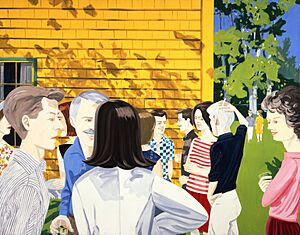
In the early 1960s, Katz started making very large paintings. He was inspired by movies, television, and billboard ads. These large paintings often show faces that are cut off, like a close-up shot. His wife, Ada Katz, has been the subject of over 250 of his portraits.
To create a large painting, Katz first makes a small oil sketch. This might take about an hour and a half. Then, he makes a detailed drawing with pencil or charcoal. The person he is painting might come back for him to make corrections. Next, he makes the drawing much bigger, sometimes using a projector. He then transfers this large drawing to a huge canvas. He uses an old technique called "pouncing." This involves pushing powdered color through tiny holes in the drawing to mark the canvas.
Before he starts painting, Katz mixes all his colors and gets his brushes ready. Then, he paints the entire large canvas, which can be 12 feet wide by 7 feet high or even bigger, in one long session of six or seven hours.
In the late 1950s, Katz started painting on cut-out panels. First, he used wood, then aluminum. He called these works "cutouts." They are like sculptures because they take up space, but they are flat like paintings. Later cutouts stand on U-shaped aluminum bases. They often show close-up views of a person's head from the front and back, or two figures looking at each other.
After 1964, Katz began painting more groups of people. He continued these complex group paintings into the 1970s. They showed the social world of artists, poets, and critics around him. He also started designing sets and costumes for the dancer and choreographer Paul Taylor in the early 1960s. He has painted many images of dancers over the years.
After his exhibition at the Whitney Museum of American Art in 1974, Katz focused on landscapes. He wanted to create landscapes that made you feel like you were "IN it." In the late 1980s, he started painting fashion models in designer clothes, including famous models like Kate Moss. He said he was interested in fashion because "it's ephemeral," meaning it changes quickly.

Printmaking by Alex Katz
In 1965, Alex Katz also began making many prints. He has created over 400 different print editions in his life. These include lithography, etching, silkscreen, woodcut, and linoleum cut. Museums like the Albertina in Vienna and the Museum of Fine Arts, Boston, have full collections of his prints.
Public Art Projects
In 1977, Katz was asked to create a large artwork for Times Square in New York City. This work was a huge billboard. It showed 23 portraits of women's heads, each 20 feet tall. The billboard stretched 247 feet along two sides of a building.
In 1980, the U.S. government asked Katz to create a large oil painting for a new building in New York City. This mural is 20 feet high and 20 feet wide. In 2005, Katz made another public art piece called Give Me Tomorrow. It was 28 feet tall and 53 feet long on a billboard.
Working with Others
Katz has worked with poets and writers since the 1960s. He created projects that combined his art with their words. For example, "Face of the Poet" featured his images with poems by writers like Ted Berrigan. He also worked with John Ashbery on "Fragment" and "Coma Berenices."
Exhibitions of Alex Katz's Art
Since 1951, Alex Katz's art has been shown in over 200 solo exhibitions. It has also been part of nearly 500 group shows around the world. His first solo show was in New York in 1954.
In 1974, the Whitney Museum of American Art showed "Alex Katz Prints." Later, in 1986, they had a traveling show of his paintings and cutouts. Many other museums have also held large exhibitions of his work. These include the Brooklyn Museum, the Jewish Museum (Manhattan), and the Irish Museum of Modern Art. In 1998, a show of his landscapes was held at the P.S. 1 Contemporary Art Center. It featured almost 40 simple paintings of city or country scenes.
In 2022, a large exhibition of his work was shown at the Thyssen National Museum of Spain. This was the first time his art was displayed in that country.
Where to See Alex Katz's Art
Alex Katz's art is in the collections of over 100 public museums worldwide. Some of these include:
- The Museum of Modern Art, New York
- The Metropolitan Museum of Art, New York
- The Whitney Museum of American Art, New York
- The Smithsonian Institution, Washington, D.C.
- The Art Institute of Chicago
- The Tate Gallery, London
- The Centre Georges Pompidou, Paris
- The Museum Brandhorst, Munich
In 2010, a collection of Katz's works was given to the National Galleries of Scotland and the Tate. In 2011, Katz donated a large artwork called Rush (1971) to the Museum of Fine Arts, Boston. This piece has 37 painted life-size cutout heads made of aluminum.
Awards and Recognition
Alex Katz has received many awards for his art. In 1972, he received the John Simon Guggenheim Memorial Fellowship for Painting. He also received awards from the Pratt Institute and the Queens Museum of Art in 1987. In 1988, he became a member of the American Academy of Arts and Letters. He has also received honorary degrees from Colby College and Colgate University.
In 1994, the Cooper Union Art School created a special teaching position called the Alex Katz Visiting Chair in Painting. Katz himself held this position first. In 2007, he received a Lifetime Achievement Award from the National Academy of Design.
In October 1996, the Colby College Museum of Art opened a large new section dedicated to Alex Katz. It features over 400 of his oil paintings, collages, and prints that he donated. He has also bought many artworks for the museum by other artists like Chuck Close and Elizabeth Murray.
In 1996, a video called Alex Katz: Five Hours was made. It showed how he created his painting January 3. In 2008, a documentary film about him was released, called What About Style? Alex Katz: a Painter's Painter.
Alex Katz's Influence
Many painters have been influenced by Alex Katz's work. These include artists like David Salle, Peter Halley, and Richard Prince. Younger artists like Peter Doig, Julian Opie, and Elizabeth Peyton have also been inspired by his unique style.
Images for kids
-
Ella Marion in Red Sweater, 1946. Museum of Modern Art
-
Art School, 1952. Pennsylvania Academy of Fine Arts Museum
-
The Red Smile, 1963. Whitney Museum
-
Red Tie, 1979. Museum of Modern Art
-
Red Coat, 1982. Metropolitan Museum of Art
-
Soho Morning, 1987. San Francisco Museum of Modern Art
-
Purple Wind, 1995. Metropolitan Museum of Art
-
Yellow House 2, 2001. Art Institute of Chicago
-
Winter Landscape, 2007. High Museum of Art
-
CK 17, 2017. Whitney Museum
See also
 In Spanish: Alex Katz para niños
In Spanish: Alex Katz para niños


